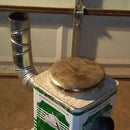Introduction: EyeClops Microscope
As I mentioned in my instructable "Wire Stripping Oven" my oldest brother works as a golf course greens assistant. He is certified and licensed also has University papers to boot to deploy chemicals against weeds anywhere in Ontario. He calls Roundup ice tea LOL. So he needs to identify bugs and all sorts of pathogens that afflict the .grasses keeping them from being nice and green. He had bought an 80X microscope at a place called Efstone Science. It like many places has closed, given up the ghost, you know Amazon and eBay does all that now. One Saturday when he came to visit I had several Eyeclops microscopes on my workbench. One is never enough, one model had a little display and a USB slot as a well as a RCA video out to connect to a TV . The other just had a magnification and RCA connector to connect to a TV. Kids toys supposedly.The unit with the little display was intermittent, I tried to fix it but no luck. The other unit functioned properly but please really can you view something at 400X without a stand.Honestly not me. I volunteered to Frankenstein something for him,. I was going to make it for myself. He paid for some items, the rest was given. What the heck family you know, he helps me I help him.
Step 1: The Build
The above labelled picture shows the final project.
Picture 5 is the schematic
Parts Used (see picture)
1xEyeclops microscope
1xA/V component to HDMI converter
1xHDMI to VGA adapter
1xregular microscope stand
1x12 volt adapter/wall wart
1x12volt to 5 volt car adapter (picture2)
1xadjustable dc to dc converter (eyclops uses 5 AA batteries, that is 7.5 volts) (picture 3)
wires, connectors and so on
Tools Used
I can say with confidence the following were used:
1xsoldering iron and electronic soldering wire
1xcordless drill and bits
and other tools associated with the undertaking of building an electronic project
I started by assembling the power supply as per picture 4.
Step 2: The EyeClops
The eyeclops unit itself had a handle as well as an external battery
compartment which also contained the digital video to analog converter. The handle was cut off, the battery compartment was removed. The video converter was placed in another case
Picture 1 shows the different units connected together and verifying things work.
Picture 2 shows piece of wood glued to eyeclops so it can be attached to microscope base
Picture 3 shows the handle cut off
Picture 4 shows the battery compartment
Picture 5 shows the video converter removed from original case
Picture 6 shows the video converter in a new case
Picture 7 shows the completed video converter
Step 3: The Light Table
The light table is the part of the microscope which provides the needed light to view specimens. It was made of ABS tubing and an led board from cheap flashlight
The above pictures show what was used for the light table
Step 4: The Final Project
I had not considered publishing this project, so I have only one picture of the final assembled unit
Step 5: Some Pictures of Magnified Items
The two pictures are of balsa wood and nylon fibers.
All in all not bad for $50.00.
100X, 200X, and 400X magnification
and NO! 400X is not enough to see YOU KNOW, need 1000X and above YUK YUK YUK











